
A Martian meteorite is a rock that formed on Mars, was ejected from the planet by an impact event, and traversed interplanetary space before landing on Earth as a meteorite. As of September 2020, 277 meteorites had been classified as Martian, less than half a percent of the 72,000 meteorites that have been classified.
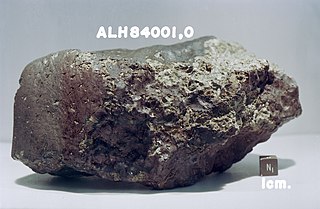
Allan Hills 84001 (ALH84001) is a fragment of a Martian meteorite that was found in the Allan Hills in Antarctica on December 27, 1984, by a team of American meteorite hunters from the ANSMET project. Like other members of the shergottite–nakhlite–chassignite (SNC) group of meteorites, ALH84001 is thought to have originated on Mars. However, it does not fit into any of the previously discovered SNC groups. Its mass upon discovery was 1.93 kilograms (4.3 lb).
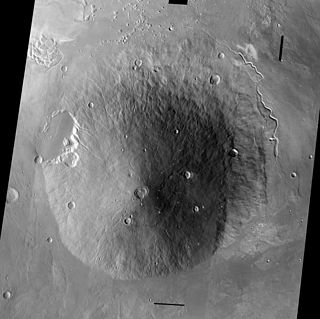
Hecates Tholus is a Martian volcano, notable for results from the European Space Agency's Mars Express mission which indicate a major eruption took place 350 million years ago. The eruption created a caldera 10 km in diameter on the volcano's western flank.
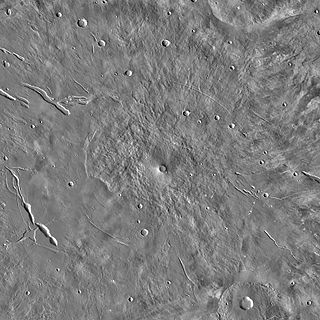
Elysium Mons is a volcano on Mars located in the volcanic province Elysium, at 25.02°N 147.21°E, in the Martian eastern hemisphere. It stands about 12.6 km (41,000 ft) above its base, and about 14.1 km (46,000 ft) above the Martian datum, making it the third tallest Martian mountain in terms of relief and the fourth highest in elevation. Its diameter is about 240 km (150 mi), with a summit caldera about 14 km (8.7 mi) across. It is flanked by the smaller volcanoes Hecates Tholus to the northeast, and Albor Tholus to the southeast.

Nakhla is a Martian meteorite which fell in Egypt in 1911. It was the first meteorite reported from Egypt, the first one to suggest signs of aqueous processes on Mars, and the prototype for Nakhlite type of meteorites.

The Shergotty meteorite is the first example of the shergottite Martian meteorite family. It was a 5-kilogram (11 lb) meteorite which fell to Earth at Sherghati, in the Gaya district, Bihar, India on 25 August 1865, and was retrieved by witnesses almost immediately. Radiometric dating indicates that it solidified from a volcanic magma about 4.1 billion years ago. It is composed mostly of pyroxene and is thought to have undergone preterrestrial aqueous alteration for several centuries. Certain features within its interior are suggestive of being remnants of biofilm and their associated microbial communities.
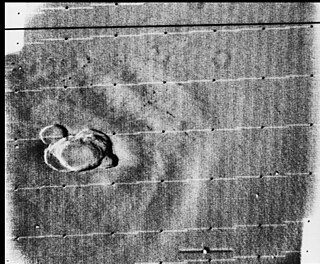
Volcanic activity, or volcanism, has played a significant role in the geologic evolution of Mars. Scientists have known since the Mariner 9 mission in 1972 that volcanic features cover large portions of the Martian surface. These features include extensive lava flows, vast lava plains, and the largest known volcanoes in the Solar System. Martian volcanic features range in age from Noachian to late Amazonian, indicating that the planet has been volcanically active throughout its history, and some speculate it probably still is so today. Both Earth and Mars are large, differentiated planets built from similar chondritic materials. Many of the same magmatic processes that occur on Earth also occurred on Mars, and both planets are similar enough compositionally that the same names can be applied to their igneous rocks and minerals.

The Amenthes quadrangle is one of a series of 30 quadrangle maps of Mars used by the United States Geological Survey (USGS) Astrogeology Research Program. The Amenthes quadrangle is also referred to as MC-14. The quadrangle covers the area from 225° to 270° west longitude and from 0° to 30° north latitude on Mars. Amenthes quadrangle contains parts of Utopia Planitia, Isidis Planitia, Terra Cimmeria, and Tyrrhena Terra.

The Tharsis quadrangle is one of a series of 30 quadrangle maps of Mars used by the United States Geological Survey (USGS) Astrogeology Research Program. The Tharsis quadrangle is also referred to as MC-9 . The name Tharsis refers to a land mentioned in the Bible. It may be at the location of the old town of Tartessus at the mouth of Guadalquivir.

The Lunae Palus quadrangle is one of a series of 30 quadrangle maps of Mars used by the United States Geological Survey (USGS) Astrogeology Research Program. The quadrangle is also referred to as MC-10. Lunae Planum and parts of Xanthe Terra and Chryse Planitia are found in the Lunae Palus quadrangle. The Lunae Palus quadrangle contains many ancient river valleys.

The Phoenicis Lacus quadrangle is one of a series of 30 quadrangle maps of Mars used by the United States Geological Survey (USGS) Astrogeology Research Program. The Phoenicis Lacus quadrangle is also referred to as MC-17. Parts of Daedalia Planum, Sinai Planum, and Solis Planum are found in this quadrangle. Phoenicis Lacus is named after the phoenix which according to myth burns itself up every 500 years and then is reborn.
Mars may contain ores that would be very useful to potential colonists. The abundance of volcanic features together with widespread cratering are strong evidence for a variety of ores. While nothing may be found on Mars that would justify the high cost of transport to Earth, the more ores that future colonists can obtain from Mars, the easier it would be to build colonies there.

Northwest Africa 7034 is a Martian meteorite believed to be the second oldest yet discovered. It is estimated to be two billion years old and contains the most water of any Martian meteorite found on Earth. Although it is from Mars it does not fit into any of the three SNC meteorite categories, and forms a new Martian meteorite group named "Martian ". Nicknamed "Black Beauty", it was purchased in Morocco and a slice of it was donated to the University of New Mexico by its American owner.
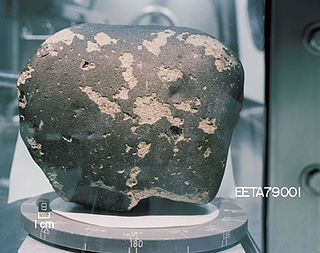
Elephant Moraine 79001, also known as EETA 79001, is a Martian meteorite. It was found in Elephant Moraine, in the Antarctic during the 1979–1980 collecting season.

Yamato 000593 is the second largest meteorite from Mars found on Earth. Studies suggest the Martian meteorite was formed about 1.3 billion years ago from a lava flow on Mars. An impact occurred on Mars about 11 million years ago and ejected the meteorite from the Martian surface into space. The meteorite landed on Earth in Antarctica about 50,000 years ago. The mass of the meteorite is 13.7 kg (30 lb) and has been found to contain evidence of past water alteration.
Catherine Margaret Corrigan, often known as Cari Corrigan, is an American scientist best known as a curator of the meteorite collection at the Smithsonian Institution. She is a scientist in the Department of Mineral Science at the National Museum of Natural History.
Researchers in December 2016 announced the discovery by the Curiosity rover of the element boron in mineral veins on the planet Mars. No other mission to Mars has found boron. However, boron was found in Martian meteorites that included MIZ 09030 in 2013, MIL 09030, Nakhla, Lafayette, and Chassigny.
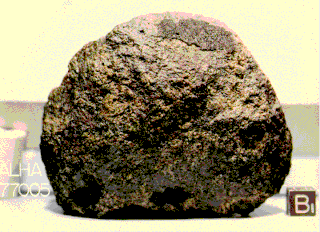
Allan Hills 77005 is a Martian meteorite that was found in the Allan Hills of Antarctica in 1977 by a Japanese National Institute of Polar Research mission team and ANSMET. Like other members of the group of SNCs, ALH-77005 is thought to be from Mars.


















